The Effects of Diabetes Mellitus on Growth, Repair, and Nursing Care
VerifiedAdded on 2022/12/16
|8
|2160
|1
Report
AI Summary
This biology report provides a comprehensive overview of diabetes mellitus, focusing on its effects on growth, repair processes, and the psychological well-being of patients, particularly in older adults. The report delves into the different types of diabetes, with a specific emphasis on type 2 diabetes, its symptoms, and the impact on homeostasis. It examines the relationship between diabetes and other health issues, such as cancer and mental disorders. The report also discusses the impact on growth and development, exploring the importance of blood glucose control and the various medications used for management. Furthermore, it highlights the psychological impacts of a diabetes diagnosis and the role of nursing care in patient management, including nursing care plans and the importance of patient education and support. The report concludes by emphasizing the need for a holistic approach to diabetes care, encompassing both medical and psychological aspects.

BIOLOGY
Paraphrase This Document
Need a fresh take? Get an instant paraphrase of this document with our AI Paraphraser
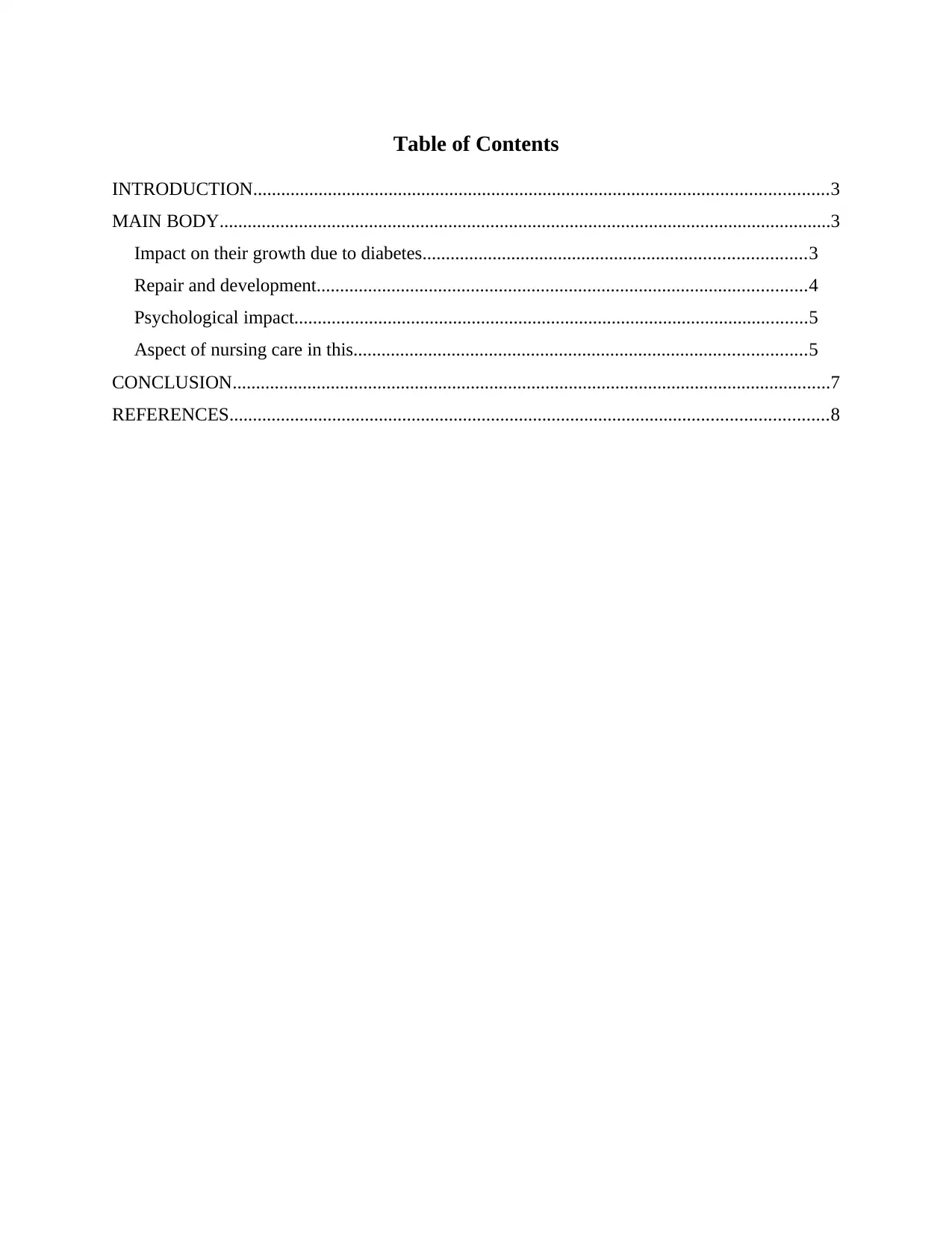
Table of Contents
INTRODUCTION...........................................................................................................................3
MAIN BODY...................................................................................................................................3
Impact on their growth due to diabetes..................................................................................3
Repair and development.........................................................................................................4
Psychological impact..............................................................................................................5
Aspect of nursing care in this.................................................................................................5
CONCLUSION................................................................................................................................7
REFERENCES................................................................................................................................8
INTRODUCTION...........................................................................................................................3
MAIN BODY...................................................................................................................................3
Impact on their growth due to diabetes..................................................................................3
Repair and development.........................................................................................................4
Psychological impact..............................................................................................................5
Aspect of nursing care in this.................................................................................................5
CONCLUSION................................................................................................................................7
REFERENCES................................................................................................................................8
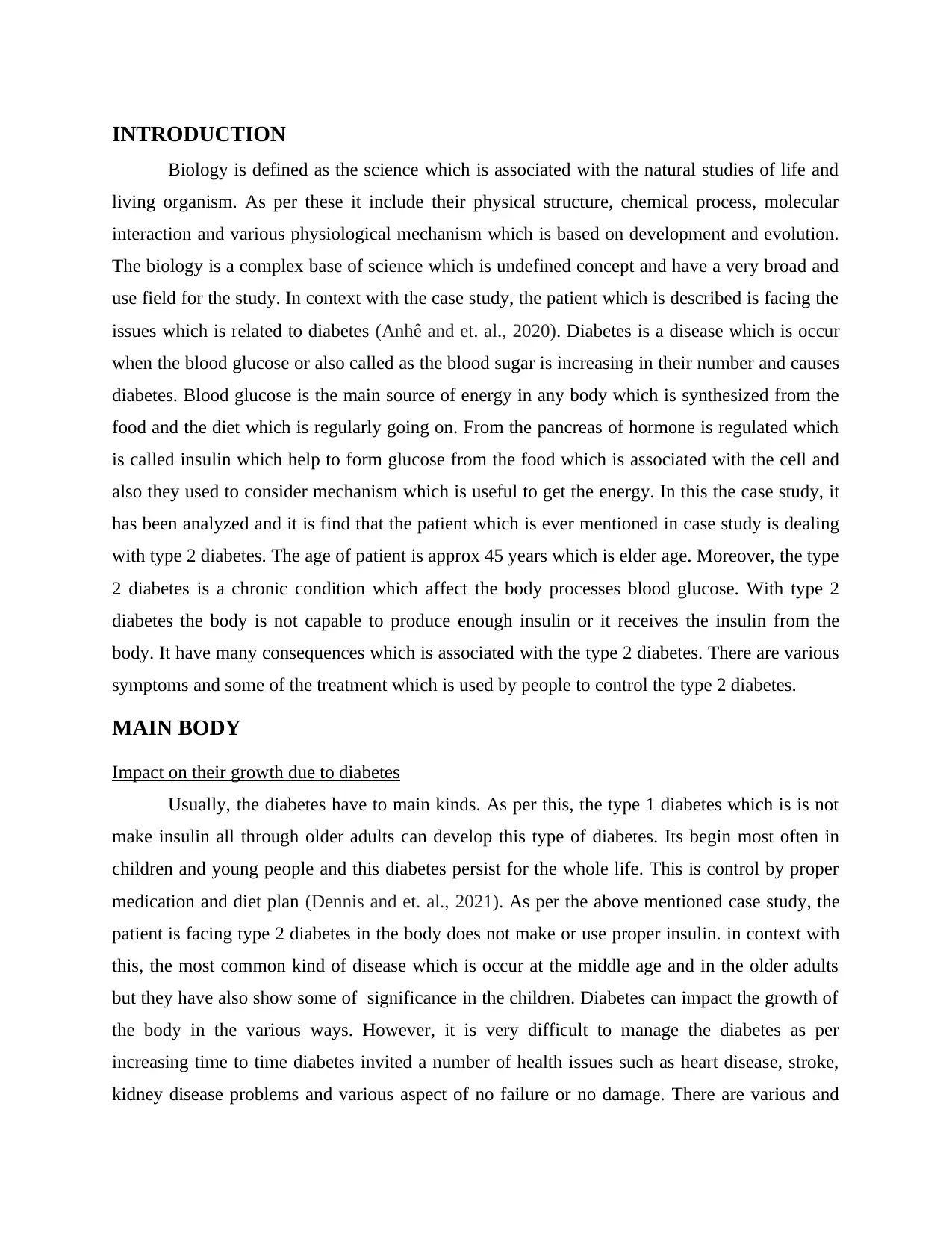
INTRODUCTION
Biology is defined as the science which is associated with the natural studies of life and
living organism. As per these it include their physical structure, chemical process, molecular
interaction and various physiological mechanism which is based on development and evolution.
The biology is a complex base of science which is undefined concept and have a very broad and
use field for the study. In context with the case study, the patient which is described is facing the
issues which is related to diabetes (Anhê and et. al., 2020). Diabetes is a disease which is occur
when the blood glucose or also called as the blood sugar is increasing in their number and causes
diabetes. Blood glucose is the main source of energy in any body which is synthesized from the
food and the diet which is regularly going on. From the pancreas of hormone is regulated which
is called insulin which help to form glucose from the food which is associated with the cell and
also they used to consider mechanism which is useful to get the energy. In this the case study, it
has been analyzed and it is find that the patient which is ever mentioned in case study is dealing
with type 2 diabetes. The age of patient is approx 45 years which is elder age. Moreover, the type
2 diabetes is a chronic condition which affect the body processes blood glucose. With type 2
diabetes the body is not capable to produce enough insulin or it receives the insulin from the
body. It have many consequences which is associated with the type 2 diabetes. There are various
symptoms and some of the treatment which is used by people to control the type 2 diabetes.
MAIN BODY
Impact on their growth due to diabetes
Usually, the diabetes have to main kinds. As per this, the type 1 diabetes which is is not
make insulin all through older adults can develop this type of diabetes. Its begin most often in
children and young people and this diabetes persist for the whole life. This is control by proper
medication and diet plan (Dennis and et. al., 2021). As per the above mentioned case study, the
patient is facing type 2 diabetes in the body does not make or use proper insulin. in context with
this, the most common kind of disease which is occur at the middle age and in the older adults
but they have also show some of significance in the children. Diabetes can impact the growth of
the body in the various ways. However, it is very difficult to manage the diabetes as per
increasing time to time diabetes invited a number of health issues such as heart disease, stroke,
kidney disease problems and various aspect of no failure or no damage. There are various and
Biology is defined as the science which is associated with the natural studies of life and
living organism. As per these it include their physical structure, chemical process, molecular
interaction and various physiological mechanism which is based on development and evolution.
The biology is a complex base of science which is undefined concept and have a very broad and
use field for the study. In context with the case study, the patient which is described is facing the
issues which is related to diabetes (Anhê and et. al., 2020). Diabetes is a disease which is occur
when the blood glucose or also called as the blood sugar is increasing in their number and causes
diabetes. Blood glucose is the main source of energy in any body which is synthesized from the
food and the diet which is regularly going on. From the pancreas of hormone is regulated which
is called insulin which help to form glucose from the food which is associated with the cell and
also they used to consider mechanism which is useful to get the energy. In this the case study, it
has been analyzed and it is find that the patient which is ever mentioned in case study is dealing
with type 2 diabetes. The age of patient is approx 45 years which is elder age. Moreover, the type
2 diabetes is a chronic condition which affect the body processes blood glucose. With type 2
diabetes the body is not capable to produce enough insulin or it receives the insulin from the
body. It have many consequences which is associated with the type 2 diabetes. There are various
symptoms and some of the treatment which is used by people to control the type 2 diabetes.
MAIN BODY
Impact on their growth due to diabetes
Usually, the diabetes have to main kinds. As per this, the type 1 diabetes which is is not
make insulin all through older adults can develop this type of diabetes. Its begin most often in
children and young people and this diabetes persist for the whole life. This is control by proper
medication and diet plan (Dennis and et. al., 2021). As per the above mentioned case study, the
patient is facing type 2 diabetes in the body does not make or use proper insulin. in context with
this, the most common kind of disease which is occur at the middle age and in the older adults
but they have also show some of significance in the children. Diabetes can impact the growth of
the body in the various ways. However, it is very difficult to manage the diabetes as per
increasing time to time diabetes invited a number of health issues such as heart disease, stroke,
kidney disease problems and various aspect of no failure or no damage. There are various and
⊘ This is a preview!⊘
Do you want full access?
Subscribe today to unlock all pages.

Trusted by 1+ million students worldwide
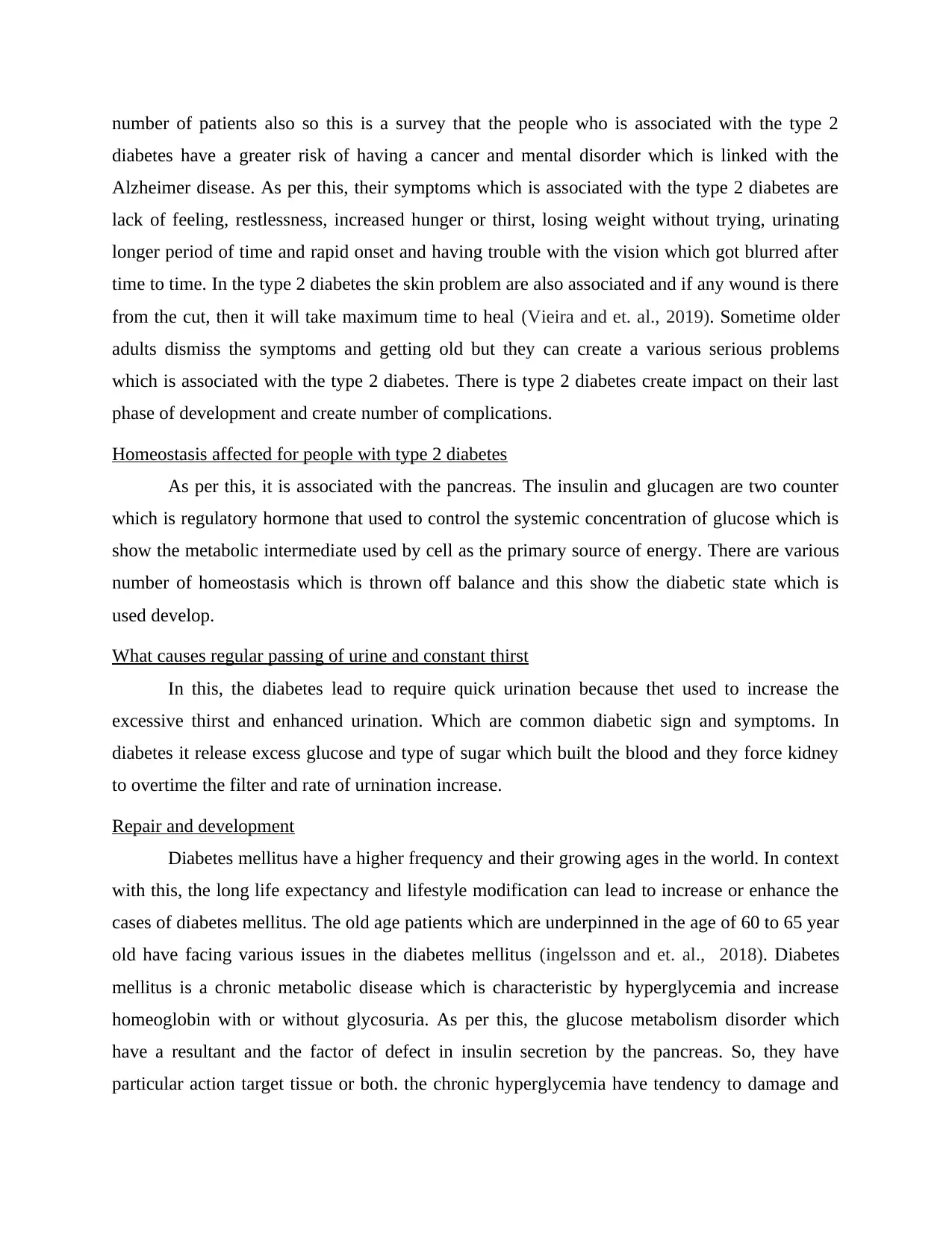
number of patients also so this is a survey that the people who is associated with the type 2
diabetes have a greater risk of having a cancer and mental disorder which is linked with the
Alzheimer disease. As per this, their symptoms which is associated with the type 2 diabetes are
lack of feeling, restlessness, increased hunger or thirst, losing weight without trying, urinating
longer period of time and rapid onset and having trouble with the vision which got blurred after
time to time. In the type 2 diabetes the skin problem are also associated and if any wound is there
from the cut, then it will take maximum time to heal (Vieira and et. al., 2019). Sometime older
adults dismiss the symptoms and getting old but they can create a various serious problems
which is associated with the type 2 diabetes. There is type 2 diabetes create impact on their last
phase of development and create number of complications.
Homeostasis affected for people with type 2 diabetes
As per this, it is associated with the pancreas. The insulin and glucagen are two counter
which is regulatory hormone that used to control the systemic concentration of glucose which is
show the metabolic intermediate used by cell as the primary source of energy. There are various
number of homeostasis which is thrown off balance and this show the diabetic state which is
used develop.
What causes regular passing of urine and constant thirst
In this, the diabetes lead to require quick urination because thet used to increase the
excessive thirst and enhanced urination. Which are common diabetic sign and symptoms. In
diabetes it release excess glucose and type of sugar which built the blood and they force kidney
to overtime the filter and rate of urnination increase.
Repair and development
Diabetes mellitus have a higher frequency and their growing ages in the world. In context
with this, the long life expectancy and lifestyle modification can lead to increase or enhance the
cases of diabetes mellitus. The old age patients which are underpinned in the age of 60 to 65 year
old have facing various issues in the diabetes mellitus (ingelsson and et. al., 2018). Diabetes
mellitus is a chronic metabolic disease which is characteristic by hyperglycemia and increase
homeoglobin with or without glycosuria. As per this, the glucose metabolism disorder which
have a resultant and the factor of defect in insulin secretion by the pancreas. So, they have
particular action target tissue or both. the chronic hyperglycemia have tendency to damage and
diabetes have a greater risk of having a cancer and mental disorder which is linked with the
Alzheimer disease. As per this, their symptoms which is associated with the type 2 diabetes are
lack of feeling, restlessness, increased hunger or thirst, losing weight without trying, urinating
longer period of time and rapid onset and having trouble with the vision which got blurred after
time to time. In the type 2 diabetes the skin problem are also associated and if any wound is there
from the cut, then it will take maximum time to heal (Vieira and et. al., 2019). Sometime older
adults dismiss the symptoms and getting old but they can create a various serious problems
which is associated with the type 2 diabetes. There is type 2 diabetes create impact on their last
phase of development and create number of complications.
Homeostasis affected for people with type 2 diabetes
As per this, it is associated with the pancreas. The insulin and glucagen are two counter
which is regulatory hormone that used to control the systemic concentration of glucose which is
show the metabolic intermediate used by cell as the primary source of energy. There are various
number of homeostasis which is thrown off balance and this show the diabetic state which is
used develop.
What causes regular passing of urine and constant thirst
In this, the diabetes lead to require quick urination because thet used to increase the
excessive thirst and enhanced urination. Which are common diabetic sign and symptoms. In
diabetes it release excess glucose and type of sugar which built the blood and they force kidney
to overtime the filter and rate of urnination increase.
Repair and development
Diabetes mellitus have a higher frequency and their growing ages in the world. In context
with this, the long life expectancy and lifestyle modification can lead to increase or enhance the
cases of diabetes mellitus. The old age patients which are underpinned in the age of 60 to 65 year
old have facing various issues in the diabetes mellitus (ingelsson and et. al., 2018). Diabetes
mellitus is a chronic metabolic disease which is characteristic by hyperglycemia and increase
homeoglobin with or without glycosuria. As per this, the glucose metabolism disorder which
have a resultant and the factor of defect in insulin secretion by the pancreas. So, they have
particular action target tissue or both. the chronic hyperglycemia have tendency to damage and
Paraphrase This Document
Need a fresh take? Get an instant paraphrase of this document with our AI Paraphraser
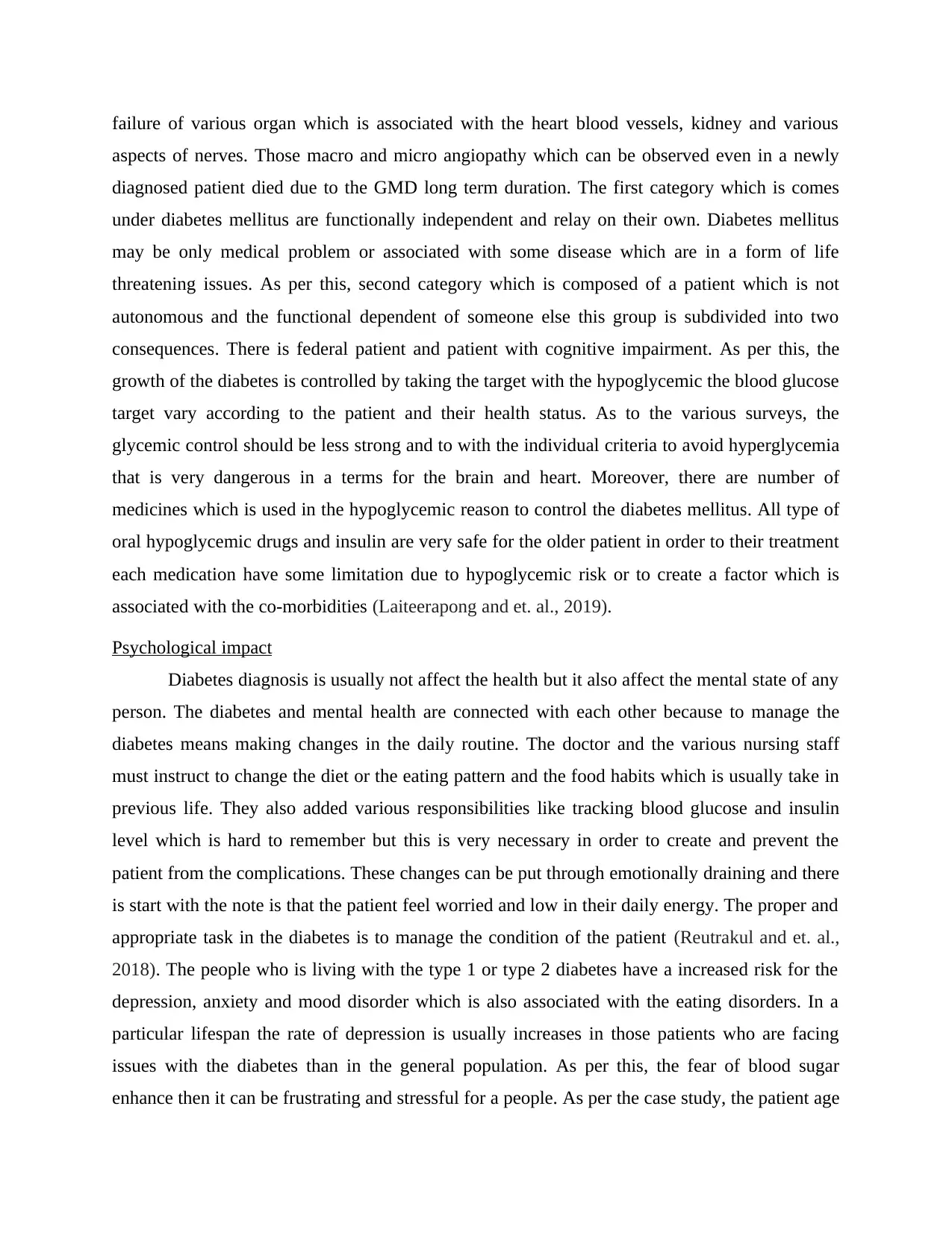
failure of various organ which is associated with the heart blood vessels, kidney and various
aspects of nerves. Those macro and micro angiopathy which can be observed even in a newly
diagnosed patient died due to the GMD long term duration. The first category which is comes
under diabetes mellitus are functionally independent and relay on their own. Diabetes mellitus
may be only medical problem or associated with some disease which are in a form of life
threatening issues. As per this, second category which is composed of a patient which is not
autonomous and the functional dependent of someone else this group is subdivided into two
consequences. There is federal patient and patient with cognitive impairment. As per this, the
growth of the diabetes is controlled by taking the target with the hypoglycemic the blood glucose
target vary according to the patient and their health status. As to the various surveys, the
glycemic control should be less strong and to with the individual criteria to avoid hyperglycemia
that is very dangerous in a terms for the brain and heart. Moreover, there are number of
medicines which is used in the hypoglycemic reason to control the diabetes mellitus. All type of
oral hypoglycemic drugs and insulin are very safe for the older patient in order to their treatment
each medication have some limitation due to hypoglycemic risk or to create a factor which is
associated with the co-morbidities (Laiteerapong and et. al., 2019).
Psychological impact
Diabetes diagnosis is usually not affect the health but it also affect the mental state of any
person. The diabetes and mental health are connected with each other because to manage the
diabetes means making changes in the daily routine. The doctor and the various nursing staff
must instruct to change the diet or the eating pattern and the food habits which is usually take in
previous life. They also added various responsibilities like tracking blood glucose and insulin
level which is hard to remember but this is very necessary in order to create and prevent the
patient from the complications. These changes can be put through emotionally draining and there
is start with the note is that the patient feel worried and low in their daily energy. The proper and
appropriate task in the diabetes is to manage the condition of the patient (Reutrakul and et. al.,
2018). The people who is living with the type 1 or type 2 diabetes have a increased risk for the
depression, anxiety and mood disorder which is also associated with the eating disorders. In a
particular lifespan the rate of depression is usually increases in those patients who are facing
issues with the diabetes than in the general population. As per this, the fear of blood sugar
enhance then it can be frustrating and stressful for a people. As per the case study, the patient age
aspects of nerves. Those macro and micro angiopathy which can be observed even in a newly
diagnosed patient died due to the GMD long term duration. The first category which is comes
under diabetes mellitus are functionally independent and relay on their own. Diabetes mellitus
may be only medical problem or associated with some disease which are in a form of life
threatening issues. As per this, second category which is composed of a patient which is not
autonomous and the functional dependent of someone else this group is subdivided into two
consequences. There is federal patient and patient with cognitive impairment. As per this, the
growth of the diabetes is controlled by taking the target with the hypoglycemic the blood glucose
target vary according to the patient and their health status. As to the various surveys, the
glycemic control should be less strong and to with the individual criteria to avoid hyperglycemia
that is very dangerous in a terms for the brain and heart. Moreover, there are number of
medicines which is used in the hypoglycemic reason to control the diabetes mellitus. All type of
oral hypoglycemic drugs and insulin are very safe for the older patient in order to their treatment
each medication have some limitation due to hypoglycemic risk or to create a factor which is
associated with the co-morbidities (Laiteerapong and et. al., 2019).
Psychological impact
Diabetes diagnosis is usually not affect the health but it also affect the mental state of any
person. The diabetes and mental health are connected with each other because to manage the
diabetes means making changes in the daily routine. The doctor and the various nursing staff
must instruct to change the diet or the eating pattern and the food habits which is usually take in
previous life. They also added various responsibilities like tracking blood glucose and insulin
level which is hard to remember but this is very necessary in order to create and prevent the
patient from the complications. These changes can be put through emotionally draining and there
is start with the note is that the patient feel worried and low in their daily energy. The proper and
appropriate task in the diabetes is to manage the condition of the patient (Reutrakul and et. al.,
2018). The people who is living with the type 1 or type 2 diabetes have a increased risk for the
depression, anxiety and mood disorder which is also associated with the eating disorders. In a
particular lifespan the rate of depression is usually increases in those patients who are facing
issues with the diabetes than in the general population. As per this, the fear of blood sugar
enhance then it can be frustrating and stressful for a people. As per the case study, the patient age
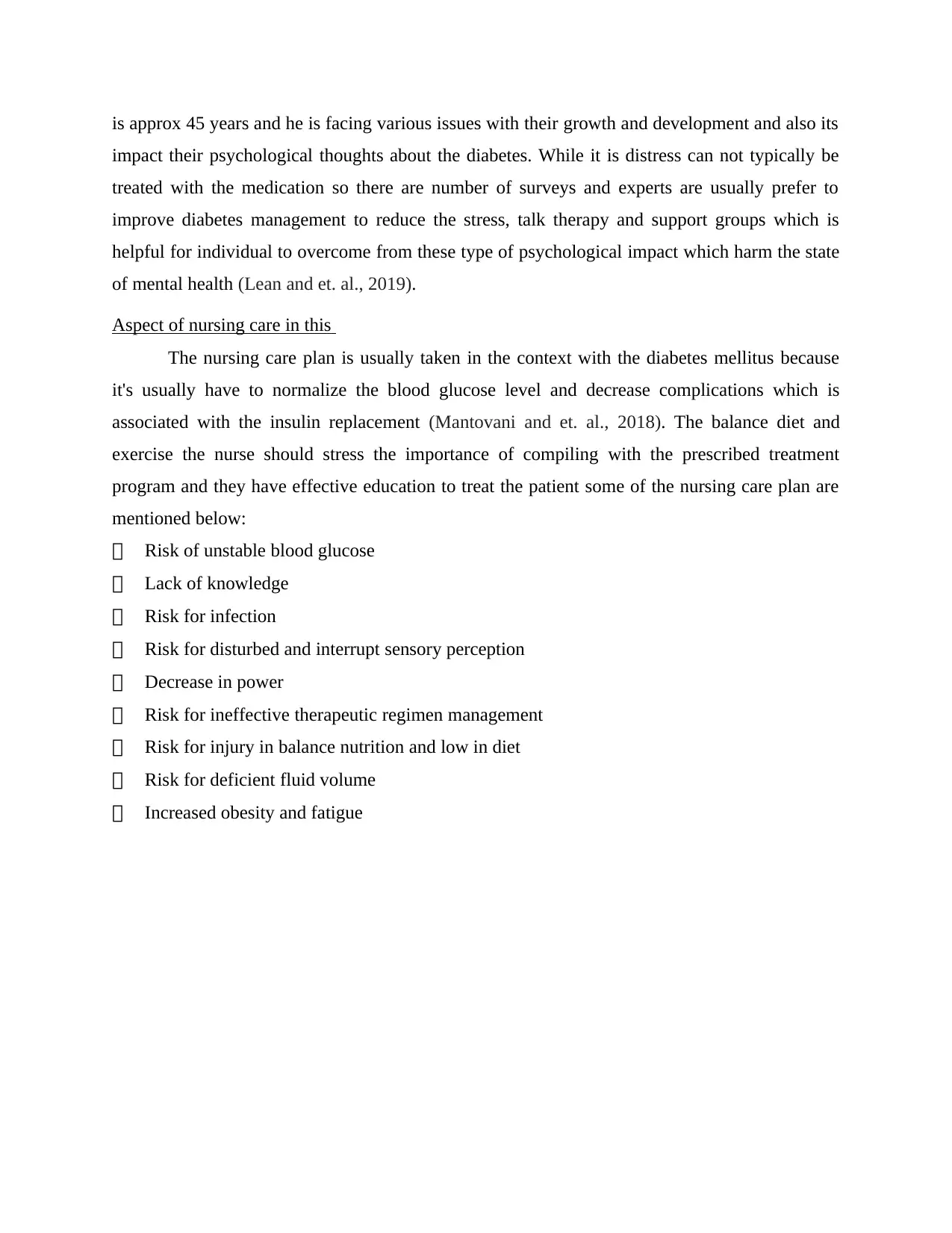
is approx 45 years and he is facing various issues with their growth and development and also its
impact their psychological thoughts about the diabetes. While it is distress can not typically be
treated with the medication so there are number of surveys and experts are usually prefer to
improve diabetes management to reduce the stress, talk therapy and support groups which is
helpful for individual to overcome from these type of psychological impact which harm the state
of mental health (Lean and et. al., 2019).
Aspect of nursing care in this
The nursing care plan is usually taken in the context with the diabetes mellitus because
it's usually have to normalize the blood glucose level and decrease complications which is
associated with the insulin replacement (Mantovani and et. al., 2018). The balance diet and
exercise the nurse should stress the importance of compiling with the prescribed treatment
program and they have effective education to treat the patient some of the nursing care plan are
mentioned below:
Risk of unstable blood glucose
Lack of knowledge
Risk for infection
Risk for disturbed and interrupt sensory perception
Decrease in power
Risk for ineffective therapeutic regimen management
Risk for injury in balance nutrition and low in diet
Risk for deficient fluid volume
Increased obesity and fatigue
impact their psychological thoughts about the diabetes. While it is distress can not typically be
treated with the medication so there are number of surveys and experts are usually prefer to
improve diabetes management to reduce the stress, talk therapy and support groups which is
helpful for individual to overcome from these type of psychological impact which harm the state
of mental health (Lean and et. al., 2019).
Aspect of nursing care in this
The nursing care plan is usually taken in the context with the diabetes mellitus because
it's usually have to normalize the blood glucose level and decrease complications which is
associated with the insulin replacement (Mantovani and et. al., 2018). The balance diet and
exercise the nurse should stress the importance of compiling with the prescribed treatment
program and they have effective education to treat the patient some of the nursing care plan are
mentioned below:
Risk of unstable blood glucose
Lack of knowledge
Risk for infection
Risk for disturbed and interrupt sensory perception
Decrease in power
Risk for ineffective therapeutic regimen management
Risk for injury in balance nutrition and low in diet
Risk for deficient fluid volume
Increased obesity and fatigue
⊘ This is a preview!⊘
Do you want full access?
Subscribe today to unlock all pages.

Trusted by 1+ million students worldwide
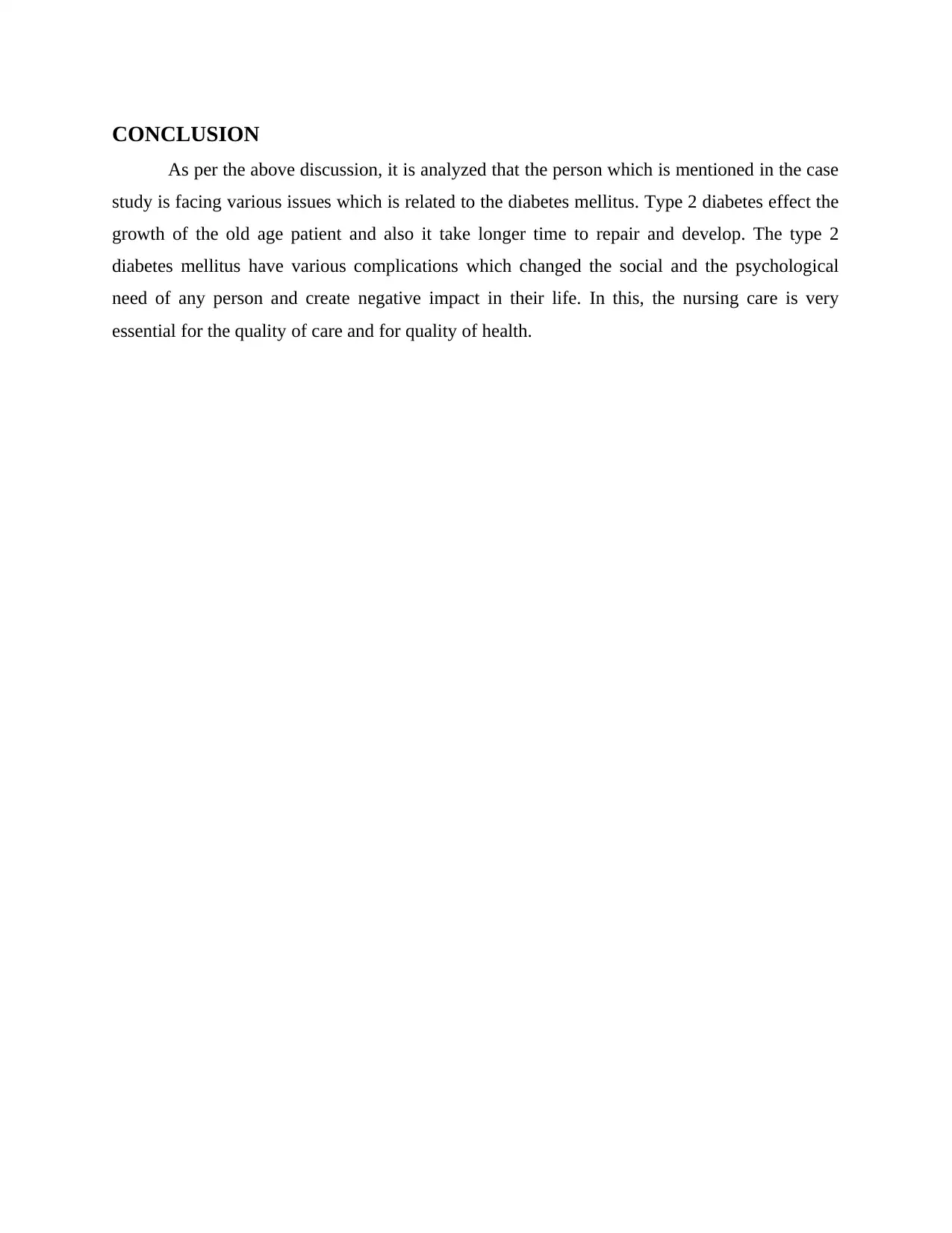
CONCLUSION
As per the above discussion, it is analyzed that the person which is mentioned in the case
study is facing various issues which is related to the diabetes mellitus. Type 2 diabetes effect the
growth of the old age patient and also it take longer time to repair and develop. The type 2
diabetes mellitus have various complications which changed the social and the psychological
need of any person and create negative impact in their life. In this, the nursing care is very
essential for the quality of care and for quality of health.
As per the above discussion, it is analyzed that the person which is mentioned in the case
study is facing various issues which is related to the diabetes mellitus. Type 2 diabetes effect the
growth of the old age patient and also it take longer time to repair and develop. The type 2
diabetes mellitus have various complications which changed the social and the psychological
need of any person and create negative impact in their life. In this, the nursing care is very
essential for the quality of care and for quality of health.
Paraphrase This Document
Need a fresh take? Get an instant paraphrase of this document with our AI Paraphraser
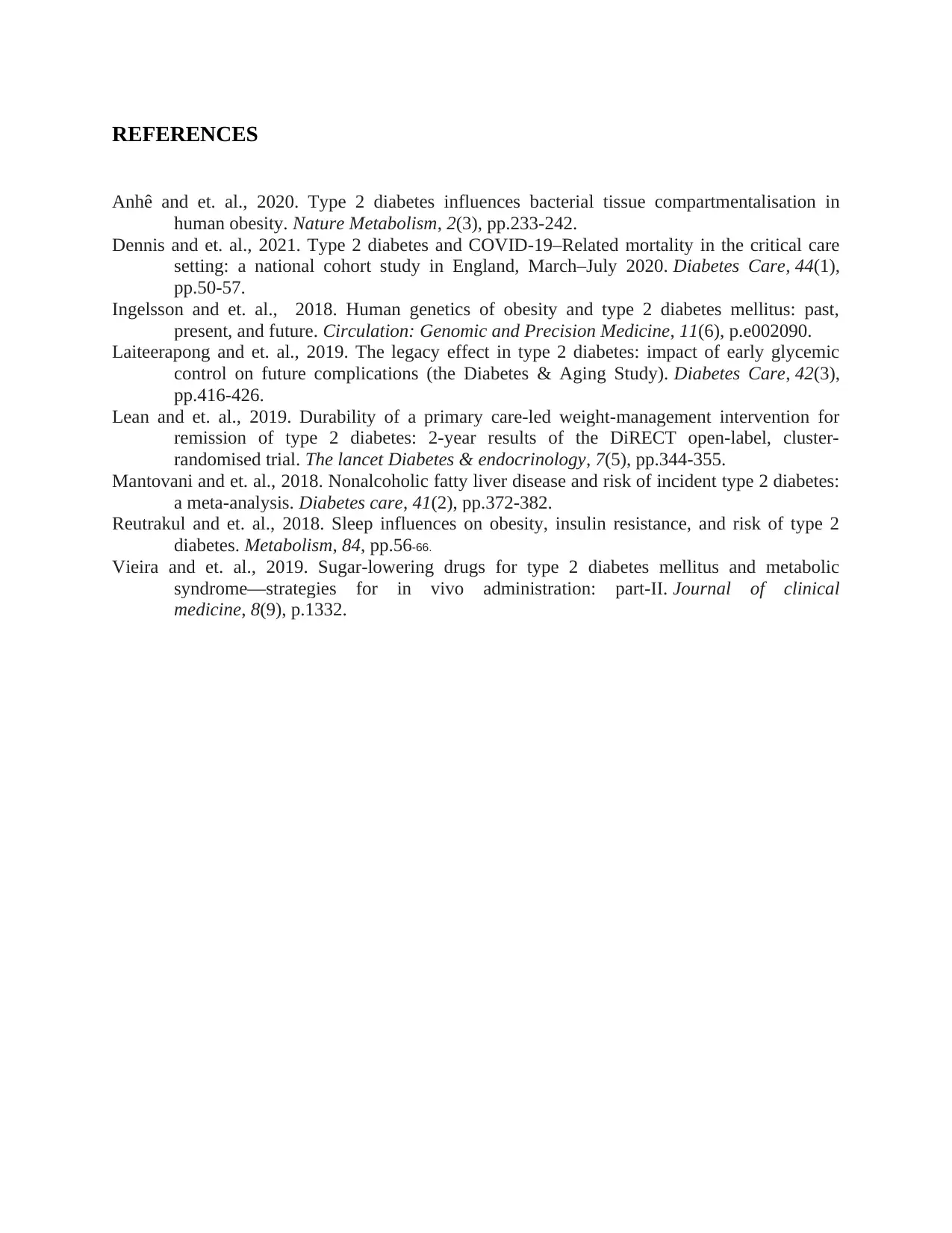
REFERENCES
Anhê and et. al., 2020. Type 2 diabetes influences bacterial tissue compartmentalisation in
human obesity. Nature Metabolism, 2(3), pp.233-242.
Dennis and et. al., 2021. Type 2 diabetes and COVID-19–Related mortality in the critical care
setting: a national cohort study in England, March–July 2020. Diabetes Care, 44(1),
pp.50-57.
Ingelsson and et. al., 2018. Human genetics of obesity and type 2 diabetes mellitus: past,
present, and future. Circulation: Genomic and Precision Medicine, 11(6), p.e002090.
Laiteerapong and et. al., 2019. The legacy effect in type 2 diabetes: impact of early glycemic
control on future complications (the Diabetes & Aging Study). Diabetes Care, 42(3),
pp.416-426.
Lean and et. al., 2019. Durability of a primary care-led weight-management intervention for
remission of type 2 diabetes: 2-year results of the DiRECT open-label, cluster-
randomised trial. The lancet Diabetes & endocrinology, 7(5), pp.344-355.
Mantovani and et. al., 2018. Nonalcoholic fatty liver disease and risk of incident type 2 diabetes:
a meta-analysis. Diabetes care, 41(2), pp.372-382.
Reutrakul and et. al., 2018. Sleep influences on obesity, insulin resistance, and risk of type 2
diabetes. Metabolism, 84, pp.56-66.
Vieira and et. al., 2019. Sugar-lowering drugs for type 2 diabetes mellitus and metabolic
syndrome—strategies for in vivo administration: part-II. Journal of clinical
medicine, 8(9), p.1332.
Anhê and et. al., 2020. Type 2 diabetes influences bacterial tissue compartmentalisation in
human obesity. Nature Metabolism, 2(3), pp.233-242.
Dennis and et. al., 2021. Type 2 diabetes and COVID-19–Related mortality in the critical care
setting: a national cohort study in England, March–July 2020. Diabetes Care, 44(1),
pp.50-57.
Ingelsson and et. al., 2018. Human genetics of obesity and type 2 diabetes mellitus: past,
present, and future. Circulation: Genomic and Precision Medicine, 11(6), p.e002090.
Laiteerapong and et. al., 2019. The legacy effect in type 2 diabetes: impact of early glycemic
control on future complications (the Diabetes & Aging Study). Diabetes Care, 42(3),
pp.416-426.
Lean and et. al., 2019. Durability of a primary care-led weight-management intervention for
remission of type 2 diabetes: 2-year results of the DiRECT open-label, cluster-
randomised trial. The lancet Diabetes & endocrinology, 7(5), pp.344-355.
Mantovani and et. al., 2018. Nonalcoholic fatty liver disease and risk of incident type 2 diabetes:
a meta-analysis. Diabetes care, 41(2), pp.372-382.
Reutrakul and et. al., 2018. Sleep influences on obesity, insulin resistance, and risk of type 2
diabetes. Metabolism, 84, pp.56-66.
Vieira and et. al., 2019. Sugar-lowering drugs for type 2 diabetes mellitus and metabolic
syndrome—strategies for in vivo administration: part-II. Journal of clinical
medicine, 8(9), p.1332.
1 out of 8
Related Documents
Your All-in-One AI-Powered Toolkit for Academic Success.
+13062052269
info@desklib.com
Available 24*7 on WhatsApp / Email
![[object Object]](/_next/static/media/star-bottom.7253800d.svg)
Unlock your academic potential
Copyright © 2020–2025 A2Z Services. All Rights Reserved. Developed and managed by ZUCOL.




